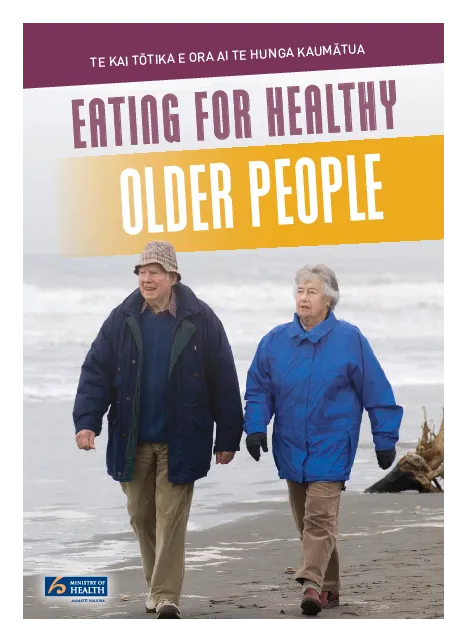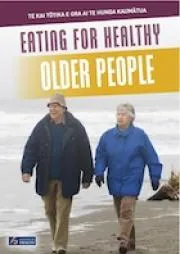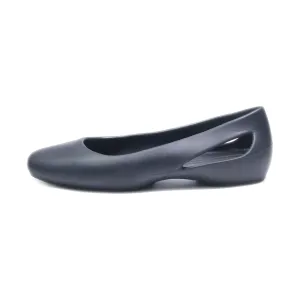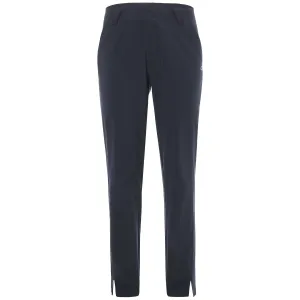Good nutrition is essential for good health
To stay healthy as you get older, it is important to eat well. You may have a smaller appetite than when you were younger, so you need to choose healthy food to get the best nutritional value.
This pamphlet includes information on healthy food choices, how to maintain a healthy weight, the benefits of including physical activity in your day, and other aspects to help you be a healthy older person.
Healthy Food Choices
Choose a variety of healthy foods every day from the following four food groups:
1. Vegetables and Fruit
Vegetables and fruit provide carbohydrates (sugar and starch), fibre, vitamins and minerals and are low in fat.
- Eat plenty of vegetables and fruit. Choose fresh, ripe varieties when they are in season. Frozen or canned varieties are also healthy options.
- Limit fruit juice and dried fruit – they are high in sugar.
- To get the best nutritional value from cooked vegetables, cook them quickly until they are just soft enough to eat. Steaming or microwaving is best. Go easy on butter or margarine.
Eat at least five servings of vegetables and fruit each day – at least three servings of vegetables and two servings of fruit (no more than one serving of fruit juice or one serving of dried fruit).
Serving size examples
Vegetables
- ½ a medium potato or similar sized piece of kūmara, taewa (Māori potato), yam, taro, cassava, or green banana (75 g)
- ½ cup cooked vegetables, eg, puha, watercress, silverbeet, taro leaves, bok choy, Chinese cabbage, broccoli, cabbage, corn or peas (50–80 g)
- 1 cup salad or bean sprouts
- 1 medium tomato (75 g)
Fruit
- 1 apple, pear, banana or orange (150 g)
- 2 small apricots or plums
- 1 cup diced or canned fruit (drained and with no added sugar), eg, pineapple (150 g)
- 1 cup frozen fruit, eg, mango, berries
2. Breads and Cereals
Breads and cereals provide carbohydrates (sugar and starch), fibre, and nutrients such as B vitamins and minerals.
- Eat plenty of breads and cereals, including rice, pasta, breakfast cereals and other grain products.
- Choose wholegrain varieties – they provide extra nutrients and fibre and also help prevent constipation.
For men, choose at least five servings of breads and cereals each day. For women, choose at least three servings of breads and cereals each day.
Serving size examples
- ½ medium roll (40 g)
- 1 medium slice rēwena bread (30 g)
- 1 slice bread (40 g)
- ⅔ cup cereal flakes
- ¼ cup muesli (30 g)
- ½ cup cooked porridge (120 g)
- ½ cup cooked pasta
- ½ cup cooked rice
- 3 crispbreads or crackers (35 g)
3. Milk and Milk Products
Milk and milk products provide protein, vitamins, calcium and other nutrients.
-
Choose reduced or low-fat milk, yoghurt and cheese if you need to lose weight.
-
Choose whole-milk products if you are underweight or need additional energy.
-
Milk and milk products provide most of the calcium you need. (For more information, see the .)
Choose at least four servings each day of milk or milk products.
Serving size examples
- 1 large glass milk (250 mL)
- ¾ cup or 1 pottle yoghurt (200 g)
- 2 slices hard cheese (40 g)
- 2 scoops ice cream (140 g)
- 1 large glass calcium-fortified soy milk (250 mL)
4. Legumes, Nuts, Seeds, Fish and other Seafood, Eggs,
Poultry (eg, Chicken), or Red Meat with the Fat Removed
This wide range of food all provide protein, vitamins and minerals to your diet. Red meat, chicken and fish contain iron in a form that your body can easily absorb. Oily fish (eg salmon, tuna, sardines and mackerel) are good sources of omega 3, which may reduce your risk of heart disease and stroke.
Legumes*, nuts and seeds also contain fibre and are a nutritious addition to your diet.
For men, choose at least three servings from this group each day. For women, choose at least two servings from this group each day.
* Legumes include cooked dried beans, peas and lentils.
Serving size examples
- 2 slices cooked meat (about 65 g), eg, beef, pork or lamb
- ½ cup mince or casserole (65 g)
- ½ medium steak (65 g)
- 2 drumsticks or ½ chicken breast (80 g)
- 1 medium, freshly cooked pāua
- small can of canned fish, eg, tuna or salmon (90 g)
- 6 freshly cooked mussels (100 g)
- 2 large (2 x 60 g) eggs
- 1 cup canned or cooked dried beans, eg, bean salad or lentil dish (150 g)
- ⅓ cup nuts or seeds
- ¾ cup tofu (170 g)
Choose and Prepare Foods Low in Fat, Salt and Sugar
- Choose polyunsaturated or monounsaturated margarine rather than butter or dripping and spread it thinly.
- Choose foods rich in polyunsaturated fat and omega-3, including, nuts and seeds, oily fish either canned or fresh (tuna, sardines, salmon, mackerel, warehou and eel) and oils (soybean, canola, flaxseed and walnut).
- Choose lean meats – trim off the fat, skim fat off stews and the top of boil ups, remove skin from chicken after cooking – and eat more grilled, baked, poached or steamed fish.
- Limit sausages or processed meats (such as ham, bacon and salami), which can be high in fat and salt – and grill rather than fry those you need to cook.
- Grill, steam, microwave, boil or bake foods without adding fat.
- Reduce the amount of sugar or salt you add when cooking foods and eat meals without adding extra salt.
- Buy frozen or canned fruit and vegetables with no or little added salt or sugar.
Many fast foods, takeaways and processed snacks are high in fat, salt and/or sugar. These include fish and chips, fried chicken, hamburgers, pies, salami, chocolate bars, muesli bars, potato chips or other salty snacks, doughnuts, cream cakes, lollies and fruit leathers. Cordials and soft (fizzy) drinks contain a lot of sugar. Choose these foods and drinks only occasionally (less than once a week). Choose these foods and drinks
only occasionally (less than once a week).
The Health Star Rating system is used on some packaged foods. You could use it to compare similar packaged foods – the more stars a food has, the healthier it is.
Calcium
Calcium is an important mineral that helps keep bones strong and reduces the risk of osteoporosis. Food is the safest, cheapest and most effective way to get calcium.
Four or more servings of milk or milk products per day will provide the calcium you need. Calcium-rich milk, yoghurt, cheese, ice cream, canned salmon or sardines (including the bones) are excellent sources of calcium.
- If you are unable to eat calcium-rich milk or milk products, talk to your doctor or dietitian before taking any supplements.
Drink Plenty of Fluids Every Day
Older people need to drink plenty of fluids to reduce the risk of constipation. Drink at least eight cups of liquid each day to replace the fluid that is lost from the body.
- Water is refreshing – keep a jug of water in the fridge or maybe have a cup of warm or hot water instead of tea or coffee.
- Tea and coffee add flavour, but don’t overdo the caffeine. Limit your daily intake to six cups of tea or four cups of coffee.
- Drink more water when the weather is hot and humid or when you are doing a lot of physical activity.
- If you find getting up during the night is a problem, try having most of your fluid earlier in the day.
Preventing Constipation
You can prevent or reduce constipation by eating high-fibre foods, drinking plenty of fluids and being physically active.
- Eat plenty of high-fibre foods, such as wholemeal or wholegrain breads, breakfast cereals, vegetables and fruit. Prunes and kiwifruit are particularly useful.
- Increase daily fluid intake to 8–10 cups. This includes tea and coffee.
- Have some regular activity every day, such as walking.
Healthy Weight in Older People
If you need to lose weight
High blood pressure, diabetes, heart disease and arthritis are common among older people. If you are overweight, losing a little weight can help to keep these conditions under better control.
- Fresh fruit and vegetables and bread and cereals are lower in energy (calories) than high-fat, high-sugar foods. Seasonal vegetables and fruit are usually good value for money.
- Eat regularly (three meals a day) but avoid high-energy snacks. Follow the suggestions on page 7 for choosing and preparing foods low in fat, salt and sugar.
- Increase your physical activity. Aim to be physically active for at least 30 minutes every day. (You can break this into three 10 minute spells.)
- Drink less alcohol – it is high in energy.
* If you have diabetes, ask your doctor to refer you to a dietitian for further advice about food. Your local Diabetes Centre is also able to help.
If you are underweight or have a small appetite
Small regular meals and nutritious snacks are recommended if you are underweight or your appetite is small.
- Thin older women are at greatest risk of bone fractures. If you are at risk, have plenty of milk and milk products to keep your bones healthy.
- Eat often – include breakfast, morning tea, lunch, afternoon tea, dinner and supper.
- Nutritious snacks include sandwiches or toast with a topping, yoghurt, milk puddings, a milk drink, soup, a scone or a muffin, a small handful of unsalted nuts or seeds.
- Keep some favourite toppings on hand, such as cheese, peanut butter, eggs, baked beans, avocado or canned fish. These all go well on bread or toast.
- Use standard or full-fat milk and full-cream yoghurts.
- Enjoy desserts such as custard, ice cream, fruit crumble, trifle or rice pudding.
As you get older, there may be times when it’s harder to shop for, prepare and cook nutritious foods.
- Use frozen or ready-to-heat dinners (eg, from supermarkets) for quick and easy meals.
- When you do feel like cooking, make larger meals sometimes and freeze portions for another day.
- Try a protein or milk-based supplementary drink (commercial products are available from a supermarket, chemist or on prescription from your GP).
Eating meals with other people
Food and eating are part of social life, which also contributes to good health. You may enjoy a meal more if you eat with others, so take advantage of opportunities to share meals with family, friends, and social groups.
Alcohol and Your Health
As you get older, your body’s ability to handle alcohol changes and you may need to limit how much you drink, or not drink at all.
- If you are taking medication, check with your doctor. Alcohol can make some medicines stronger or weaker, or make their side-effects worse.
- Drinking alcohol can also make any existing health problems, such as diabetes, worse and cause new health problems.
- You should not drink alcohol if you feel unwell, depressed, tired or cold as it could make things worse.
- You can reduce the alcohol you drink by alternating between non-alcoholic and alcohol drinks, and by drinking low-alcohol beverages.
- If you're having trouble stopping or cutting back on how much alcohol you drink, talk to your doctor or another health professional.
- Alcohol is high in energy, so drink less if you need to lose weight.
Be Physically Active
Physical activity is just as important for older people as it is for everyone else. Physical activity keeps muscles strong and flexible. It helps you maintain a healthy body weight, sleep better and feel fit and well. It can also improve your balance and reduce your risk of falling.
Be physically active by taking every opportunity to move. Try to include 30 minutes of physical activity on most if not all days of the week
You can break your 30 minutes into three spells of 10 minutes each.
Maintain or increase your regular daily activity – household tasks such as vacuuming, cleaning and gardening count here!
Walk whenever you can. Walking is an excellent activity – just make sure that you have comfortable well-fitting shoes. If you prefer to walk with others, walk with a friend or join a walking group or a tramping club.
Other activities, some of which give you social contact as well as physical activity, include:
- swimming or aqua aerobics (good for joints as it is impact-free)
- sports such as bowls, croquet, golf or tennis
- cycling – outdoors (remember to wear a helmet!) or indoors on an exercycle
- old time or line dancing, kapa haka or traditional dance
- tai chi or yoga.
Vitamin D
If you don’t get outside every day, you may not be getting enough vitamin D. Vitamin D is absorbed from sunlight on the skin. It is also found in eggs, margarine, fish and seafood. In special cases, frail older people may need a Vitamin D supplement, but for most people it is better to have short regular exposure to the sun.
- A daily walk or some other form of physical activity in the early morning or late afternoon is recommended. In general between September and April sun protection is recommended (shade, clothing coverage and a hat that shades the face and neck, sunscreen and sunglasses) especially between 10 am and 4 pm. Between May and August some sun exposure is important. A daily walk or another form of physical activity in the hours around noon, with face, arms and hands exposed, is recommended.
- If you think you may not be getting enough vitamin D, talk to your doctor or dietitian before taking a Vitamin D supplement.
Food Safety
It is always important to keep food safe because food poisoning can have a severe effect. Think about food safety when you purchase, prepare, cook and store food.
- Keep cooked food and ready-to-eat foods separate from raw and unprocessed foods to avoid cross-contamination.
- Wash your hands, utensils and chopping boards thoroughly with hot, soapy water before preparing a different food to avoid cross-contamination.
- Wash raw vegetables and fruit thoroughly.
- Eat freshly cooked foods as soon as possible after cooking.
- Use cooked or prepared foods that have been stored in the refrigerator within two days.
- Take care to reheat cooked food thoroughly so that it is steaming hot. If you are using a microwave, make sure that the food is evenly cooked or heated.
For more information
- Doctor or practice nurse
- Community Health Centre of Public Health Service
- Local community dietitian
For website information
- Ministry of Health
- Health Education resources
- Te Hiringa Hauora/Health Promotion Agency
- Age Concern
ISBN 978-0-478-19377-0 (print)
ISBN 978-0-478-19378-7 (online)

 Cart(
Cart(












